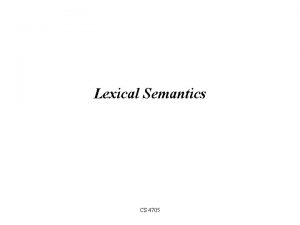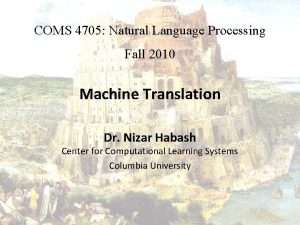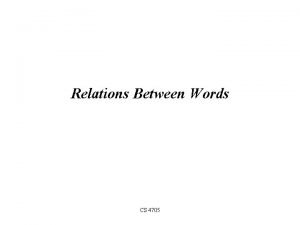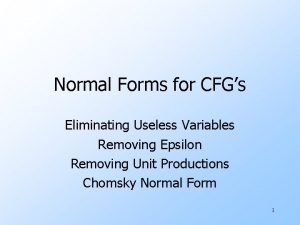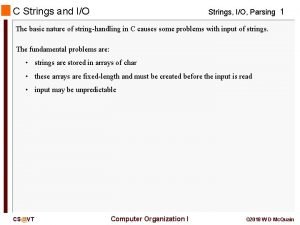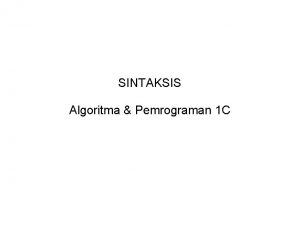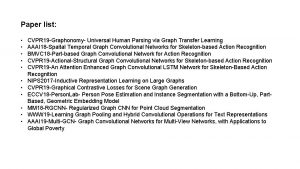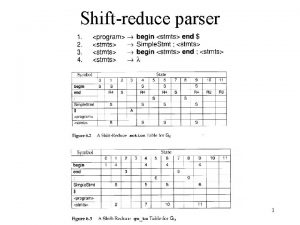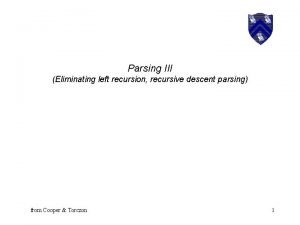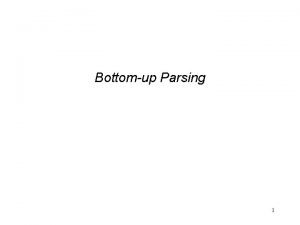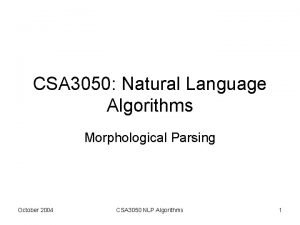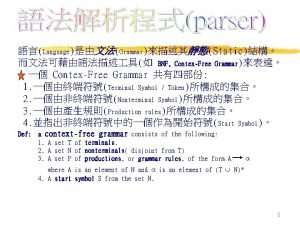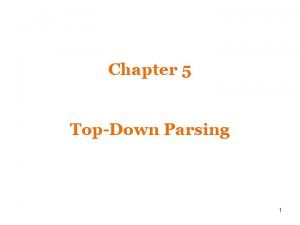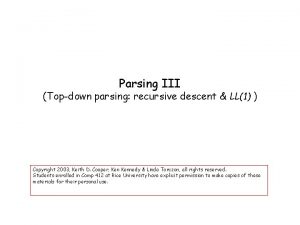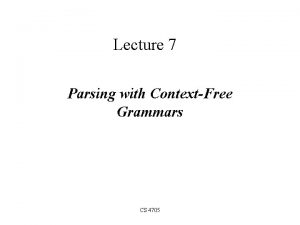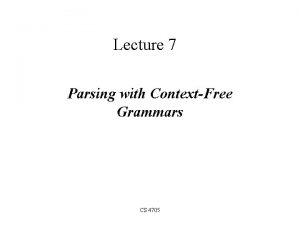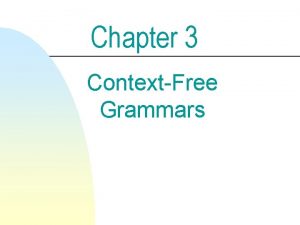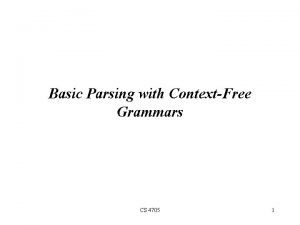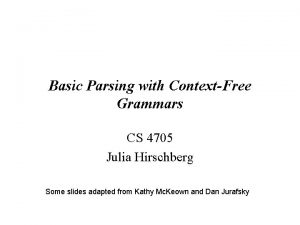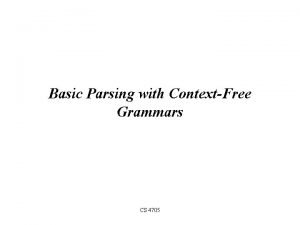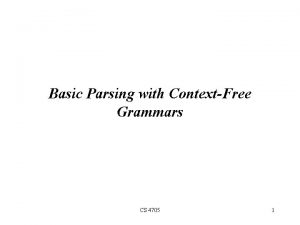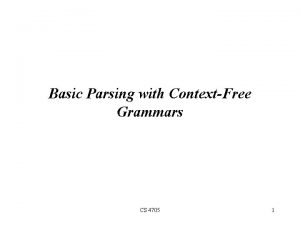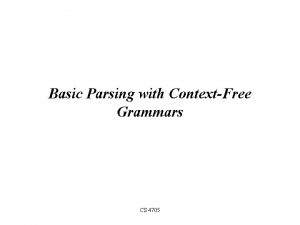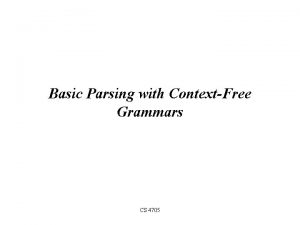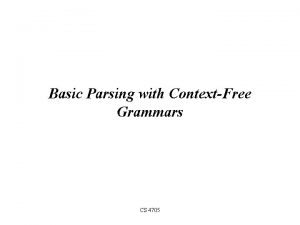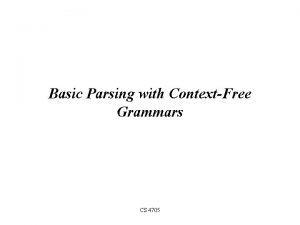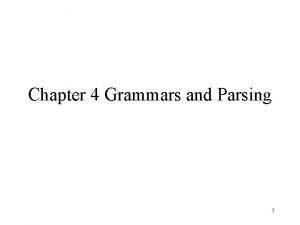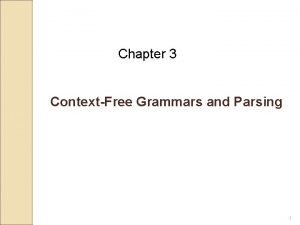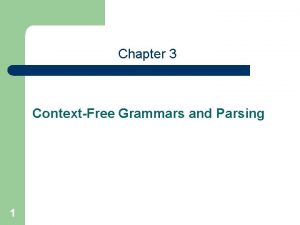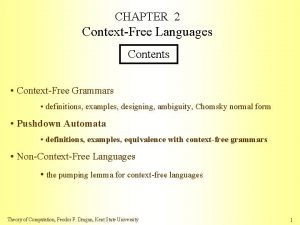Lecture 7 Parsing with ContextFree Grammars CS 4705



















- Slides: 19

Lecture 7 Parsing with Context-Free Grammars CS 4705

Linguistic Representations • Sounds – Phonemes, Words, Intonational phrases • Words – Classes: groups of words which behave similarly – Function/Content – P. O. S. : Nouns, Verbs, Adjectives, Prepositions • Constituents: – Groupings of words into larger units which behavior similarly and have a particular p. o. s. as their head – Phrases: NP headed by Noun. . . VP, PP, . . . • Discourses

Analyzing Language in Terms of these Representations • Morphological parsing: – analyze words into morphemes and affixes – rule-based, FSAs, FSTs • Phonological parsing: – analyze sounds into words and phrases • POS Tagging • Syntactic parsing: – identify component parts and how related – to see if a sentence is grammatical – to assign a semantic structure

Syntactic Parsing • Declarative formalisms like CFGs define the legal strings of a language but don’t specify how to recognize or assign structure to them • Parsing algorithms specify how to recognize the strings of a language and assign each string one or more syntactic structures • Parse trees useful for grammar checking, semantic analysis, MT, QA, information extraction, speech recognition…and almost every task in NLP

Parsing as a Search Problem • Searching FSAs – Finding the right path through the automaton – Search space defined by structure of FSA • Searching CFGs – Finding the right parse tree among all possible parse trees – Search space defined by the grammar • Constraints provided by the input sentence and the automaton or grammar

CFG for Fragment of English S NP VP S Aux NP VP S VP NP Det Nom VP V Det that | this | a N book | flight | meal | money V book | include | prefer NP Prop. N Nom Nom N Nom PP VP V NP Aux does Prep from | to | on Prop. N Houston | TWA Top. D Bot. Up E. g. LC’s

Parse Tree for ‘Book that flight’ for Prior CFG S VP NP Nom V Book Det that flight N

Top-Down Parser • Builds from the root S node to the leaves • Assuming we build all trees in parallel: – – Find all trees with root S (or all rules w/lhs S) Next expand all constituents in these trees/rules Continue until leaves are pos Candidate trees failing to match pos of input string are rejected (e. g. Book that flight can only match subtree 5)

Top-Down Search Space for CFG (expanding only leftmost leaves) S NP S VP S Aux NP S VP S S S VP NP VP Aux NP VP VP VP Det Nom Prop. N V NP V Det Nom N

Bottom-Up Parsing • Parser begins with words of input and builds up trees, applying grammar rules w/rhs match – Book that flight N Det N V Det N Book that flight – ‘Book’ ambiguous – Parse continues until an S root node reached or no further node expansion possible

Two Candidates: One Successful Parse S VP VP NP V Det Book that Nom N V flight Book that NP Nom Det N flight

Comparing Top-Down and Bottom-Up • Top-Down parsers never explore illegal parses (e. g. can’t form an S) -- but waste time on trees that can never match the input • Bottom-Up parsers never explore trees inconsistent with input -- but waste time exploring illegal parses (no S root) • For both: how to explore the search space? – Pursuing all parses in parallel or …? – Which rule to apply next? – Which node to expand next?

A Top-Down Parsing Strategy • Depth-first search: – Agenda of search states: expand search space incrementally, exploring most recently generated state (tree) each time – When you reach a state (tree) inconsistent with input, backtrack to most recent unexplored state (tree) • Which node to expand? – Leftmost or rightmost • Which grammar rule to use? – Order in the grammar

Top-Down, Depth-First, Left-Right Strategy • Initialize agenda with ‘S’ tree and ptr to first word and make this current search state (cur) • Loop until successful parse or empty agenda – Apply all applicable grammar rules to leftmost unexpanded node of cur • If this node is a POS category and matches that of the current input, push this onto agenda • O. w. push new trees onto agenda – Pop new cur from agenda • Does this flight include a meal?

Fig 10. 7 CFG

Augmenting Top-Down Parsing with Bottom. Up Filtering • We saw: Top-Down, depth-first, L 2 R parsing – Expands non-terminals along the tree’s left edge down to leftmost leaf of tree – Moves on to expand down to next leftmost leaf… – In a successful parse, current input word will be first word in derivation of node parser currently processing – So…. lookahead to left-corner of the tree in • B is a left-corner of A if A =*=> B • Build table with left-corners of all non-terminals in grammar and consult before applying rule

Left Corners

Left-Corner Table for CFG

Summing Up • Parsing is a search problem which may be implemented with many search strategies – Top-Down or Bottom-Up approaches each have problems – Combining the two solves some • Next time: Read Ch 10. 3 -4 • For fun: Work on your homework….
 Today meaning
Today meaning Coms 4705
Coms 4705 4705 in word
4705 in word Regular grammars generate regular languages.
Regular grammars generate regular languages. Removing epsilon productions from cfg
Removing epsilon productions from cfg Unrestricted grammer
Unrestricted grammer Unrestricted grammars
Unrestricted grammars Questions on context free grammar
Questions on context free grammar 01:640:244 lecture notes - lecture 15: plat, idah, farad
01:640:244 lecture notes - lecture 15: plat, idah, farad String parsing in c
String parsing in c Yang memeriksa sintaks dan memeriksa relasi adalah
Yang memeriksa sintaks dan memeriksa relasi adalah Cvpr paper list
Cvpr paper list Parsing
Parsing The left recursion produces
The left recursion produces Top down parsing vs bottom up
Top down parsing vs bottom up Top down parsing in nlp
Top down parsing in nlp Morphological parsing in nlp
Morphological parsing in nlp Lr parsing table example
Lr parsing table example Recursive descent
Recursive descent Predictive parsing
Predictive parsing
